
Ethel Bailey’s early 20th-century postcard collection
Ethel Bailey was born in 1888 and lived for most of her life at 93 Bouverie Road in Hackney, North London. It was an attractive, modern house on a leafy street popular with middle-class office workers and craftsmen. She was part of a big family who must have enjoyed their home life since none of the adult children seemed in a hurry to move out. In the year that Ethel turned 23, the 1911 Census for England and Wales records those in the house as her parents Maria, a Londoner aged 61, and Horace, 62, who worked as a carpenter and was originally from Norfolk, four older siblings Horace, 37, who was also a carpenter, Albert (Alb), 35 and Alfred (Alf), 31, who were clerks for a tea merchant and a bank respectively, and Emily, 26, who helped run the household, plus a younger brother Edwin (Ted), 20, who was also working as a clerk. Another brother James (Jim), 35, is away in the navy. In the 2021 census he is at home with his occupation recorded as a ship’s clerk.
Ethel, who is working as a sewing machinist, kept the postcards Jim sent home in albums alongside others that landed on No 93’s doormat from friends and family (and often herself). Like thousands of others, she was enjoying a craze for postcards that had been kickstarted in 1902, when photographs and illustrations were allowed to cover the entirety of one side for the first time with the flip side divided in half for a message and address. The fashion lasted until the outbreak of World War I, by which time Ethel had collected postcards that tell stories of emigration to Canada, major events in San Francisco, the Chinese revolution and the hidden Empire of Japan - plus an extensive look at English seaside resorts in their glory years.
Still living at 93 Bouverie Road in the 1960s, Ethel gave her postcard albums to a young neighbour, Pearl, who had enjoyed looking through them with her. They have been treasured ever since and some of the postcards are shown here with her kind permission. There is no information in the albums but with research and a little bit of guesswork, we are building up snapshots of her life and times. If anybody recognises the people featured or has extra information to offer please do write to us at ATripUpMySleeve.gmail.com. We would love to hear from you!
Beside the seaside
-
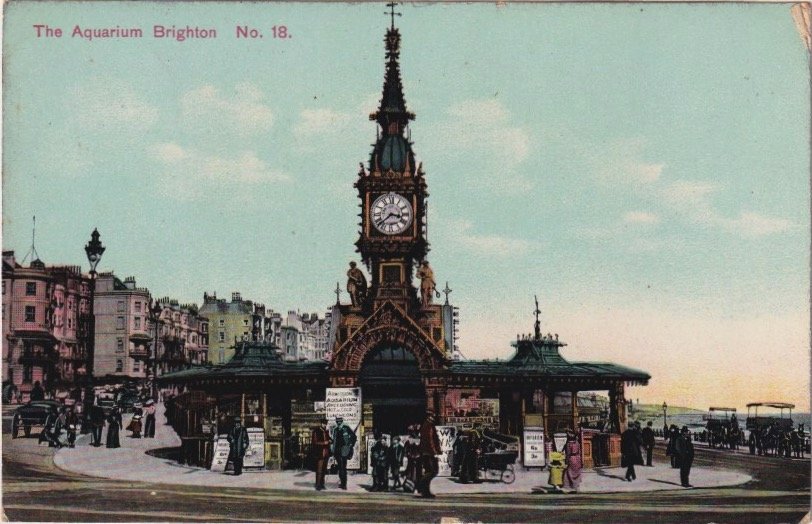
The Aquarium, Brighton, August 14 1904
Ethel has turned 16 this year, and this is the earliest seaside postcard in her collection, sent home by herself. She placed it at the top of the first page of her album. So is this her first holiday without her parents? And is this postcard, showing Brighton Aquarium the first one she has ever written? It’s certainly a functional, frill-free piece of communication! “Dear Em,” she writes to her older sister. “Coming home by first train. Tell Mum to have my dinner ready about 12.30 I think. Yours Ethel.”
-

-

Convict ship, Weymouth, September 4 1905
The following year older sister Emily is on holiday in Dorset. This postcard, titled ‘Australian convict ship (The only one left). A Wonderful Interior’, shows a grim tourist attraction on Weymouth harbour - a prison ship that transported English convicts to colonial Australia in a practice that had ended only 37 years earlier. She writes to her mother: “Just been over this ship and felt very frightened. It gave us the horrors. Em.”
-

-
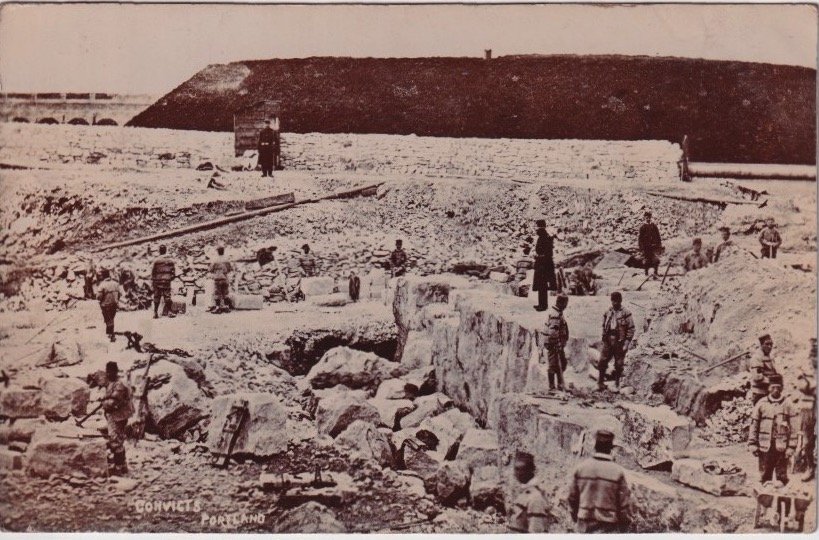
Portland, Dorset, September 12 1905
Emily again shows her interest in life’s darker side with a second outing on her Dorset holiday - this time to Admiralty Quarries, which produced Portland stone using convict labour - men in chains from Portland Prison. She writes: “We saw the quarries and the prison but did not see the convicts at work as it was Sunday (they do not work on Sunday). It was a dreadful hill to climb. I would not climb it again at any price. Lovely day today, sun shining and no wind. Hope it will last. Love to all from Em.”
-

-
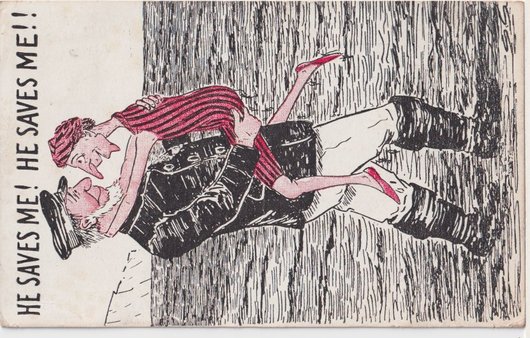
He saves me! August 8 1907
Ethel is on holiday (possibly staying with family) in Great Yeldham, a village in Suffolk. She has sent a postcard to a friend Ria, who replies with this cheeky one : “Dear Ethel,” she writes. “Glad you are enjoying yourself, keep on doing so. Miss [indecipherable] thanks for card, don’t you wish you were in Brighton so you could be clasped in the arms of a [indecipherable] fisherman. Love Ria”.
-

-

Landslip at Black Rock, Brighton, August 8 1908
By 1908 Ethel has visited Brighton several times and adopts a slightly superior tone about her friend Flo’s excitement. “Dear Em,” she writes. “Arrived safe about 4.30, three others in room. Flo can’t get over the wonderful sea. All she keeps saying is ‘Oh, aint it grand, ain’t it lovely.’ Ethel”.
-

-
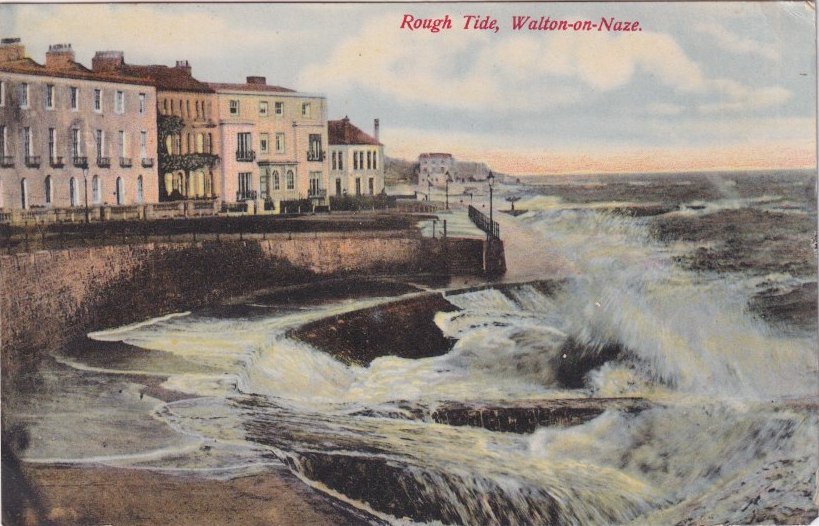
Walton on the Naze, Essex, July 23 1908
The postcard is titled Rough Tide, but Ethel is having calmer weather. She writes to her sister: “We are having a lovely tome. Grand day, been to bathe.Ethel.”
-
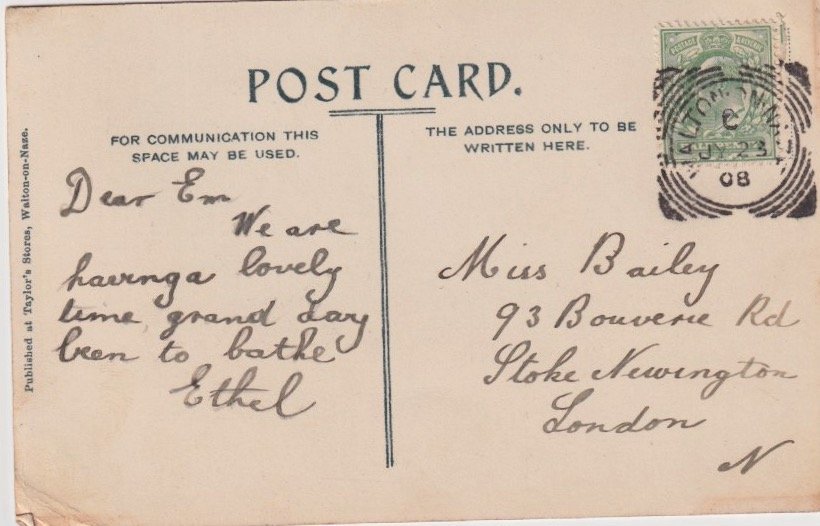
New List Item
Description goes here -

Great Yarmouth, Norfolk, September 9 1909
Ted writes: ” Yarmouth Sunday. Shall be home Wednesday night some time. Ted”.
-

-
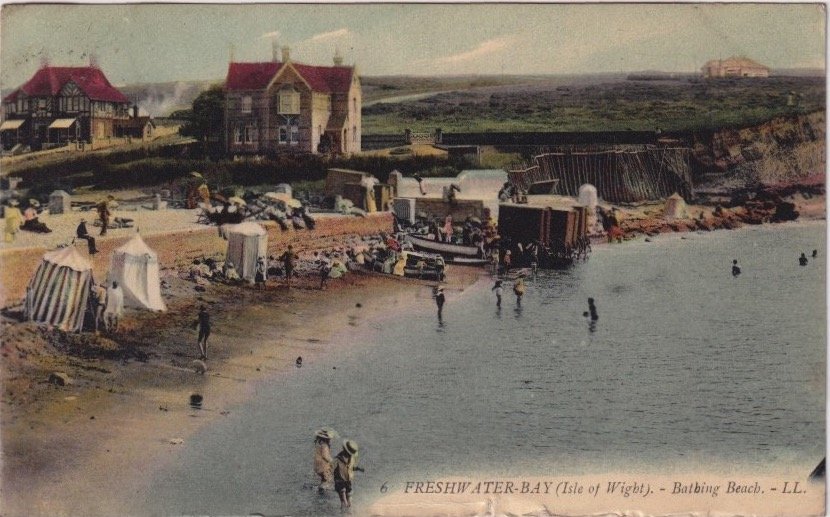
Freshwater Bay, Isle of Wight, July 4
Although the date is obscured here, the year must be 1911 (the year when stamps showing George V were first used) or later. She is obviously thrilled by the Isle of Wight. “Dear Emily, Simply lovely here. You would love it. Love Ethel”
-

-

Southampton, June 8 1914
Less than two months before the start of WWI, 23-year-old Ted is on a carefree cycling holiday and mixing activity with entertainment. He writes: “(88 miles) Dear Mum, Arrived here OK at 6pm. Had rather heavy local showers all the way, did the last 2 miles in 7 minutes & arrived 5 minutes ahead of a big thunderstorm. Tell Horace I am going to see Jwegoliah??? tonight & Haley’s Juveniles. Please send any letters or wires to PO Box xx until Thursday night. Ted.” Gracie Fields had been one of the performers in Hayley’s Juveniles.
NB Ted turns up safe and well in the 1921 Census and married to a Margaret Betts.
-

-

Great Yarmouth, date unclear
“Dear E, What is the weather like in London, it is very cold & showery here, it was lovely yesterday though, I got burnt up. It is the regatta today, going to have fireworks on the pier tonight, just going to have a look at the fun. Em. Just had a card from Alf in Snowdon. Write and tell me all the news.”
-

Canada, here we come
-

Liverpool, England, April 4 1905
Several million Brits headed out to a new life in Canada between 1903 and 1913. Maria’s nephew Jack is about to become one of them. He dashes off a card to her from Liverpool, franked at 10.30am on April 4 1905, just before he leaves England: “Have arrived quite safe. Very tired and wet. Looking forward to a sleep. Sail at 3.30. Good Bye. Best wishes to all. JACK.”
-
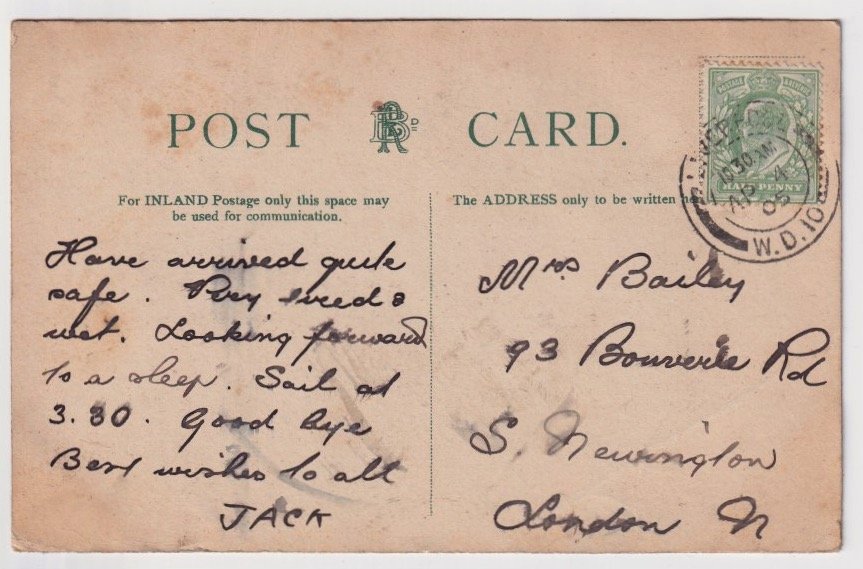
-

Montreal, Canada, April 24 1905
Three weeks later Jack has arrived safely and is finding his feet. He writes from Montreal: “Dear Aunt, Hope you are well. Am doing fine myself. Plenty of work here & no men to do it. They all go west this time of year. Don’t think I shall come back. Best wishes to all from yours affectionately, Jack”
-

-
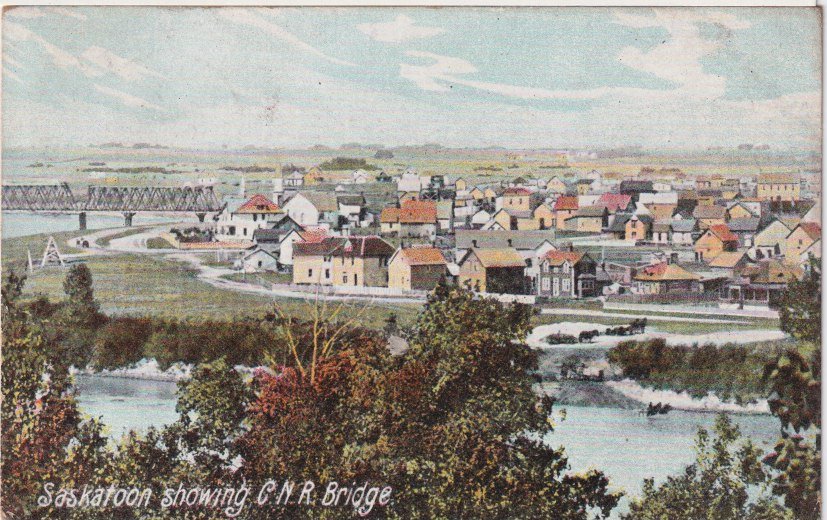
Saskatoon, Canada, November 1909
Saskatoon in Saskatchewan, on the prairies of West Canada, had a population of just a few thousand. But it was one of the country’s fastest growing cities thanks to river crossings for railways like the new Grand Trunk Bridge shown on the card. It is sent to Emily by Harry, who somehow has a strong connection to the whole family. “Dear Emma,” Harry writes, “just a few lines hoping you are quite well as this leaves me, I am still at the same old job, give my love to all, and accept the same yourself HARRY
-

-
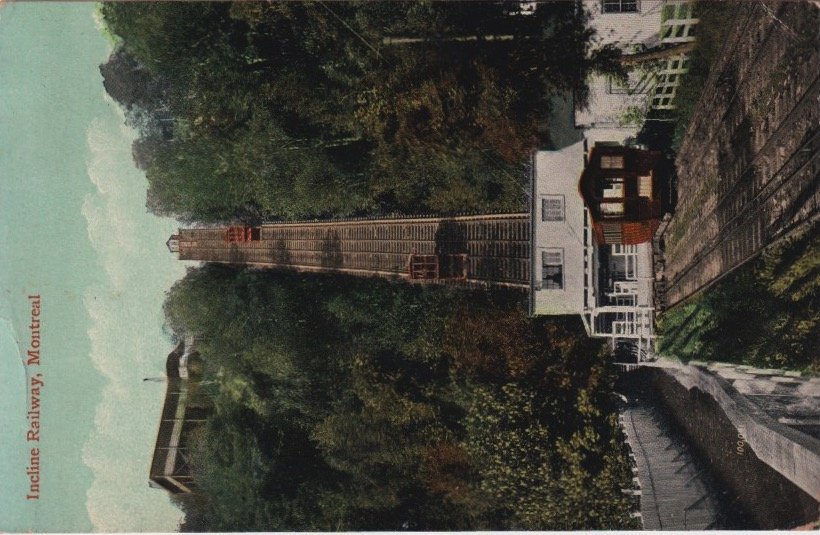
Montreal, May 29 1911
Two years later, another family member had headed across the Atlantic - Ada, Maria’s niece who has been a close-knit member of the family. “Dear Aunt,” she writes. “We arrived in Montreal Thursday 25th about 12 o’clock noon. We were one day late for it was very foggy at Newfoundland. Harry & Jack were there to meet me, we were two hours getting through the customs. I went up this elevator on Sunday with Jack and Mary, it takes us up to the mountains. There is a lovely view of the city when you get to the top. Best love from all, Ada.” Are Ada and Jack brother and sister? Are Jack and Harry schoolfriend? Is Mary Jack’s new wife? We can only guess.
-

-

Montreal, Park Avenue in Winter, November 20 1911
Six months later, Ada - signing herself AD - is still in Canada and clearly wants to share a photograph showing the extreme nature of her first Canadian winter. “This is near where Lucy lives. We are all quite well. Hope you are the same. AD.”
-

-
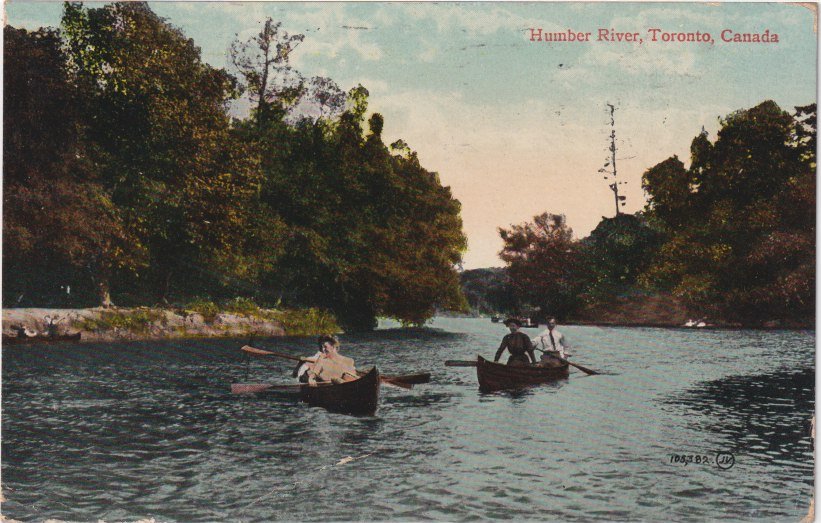
Humber River, Toronto, Canada, August 14 1914
Three years later, and while war has broken out in Europe, this postcard from Ada on holiday in Toronto, radiates peace and calm. She writes to her aunt: “Arrived here from Montreal by boat. We were exactly two days on the water and two nights. The weather was perfect, it was a lovely trip. On Monday we are going to Niagara Falls, Love from Ada”
-

-

New York, Jun 1 1922
Eight years have passed and Ada is visiting New York as a Canadian for what seems to be the first time: “Dear Aunt, I am having a fine time here, glorious weather. New York is a wonderful city, very up to date. We are taking in all the sights. Love from Ada.” The Hotel Commonwealth, shown on the postcard and mooted to be the biggest and grandest in the world, was actually never built after the plans fell apart amidst accusations of fraud.
-
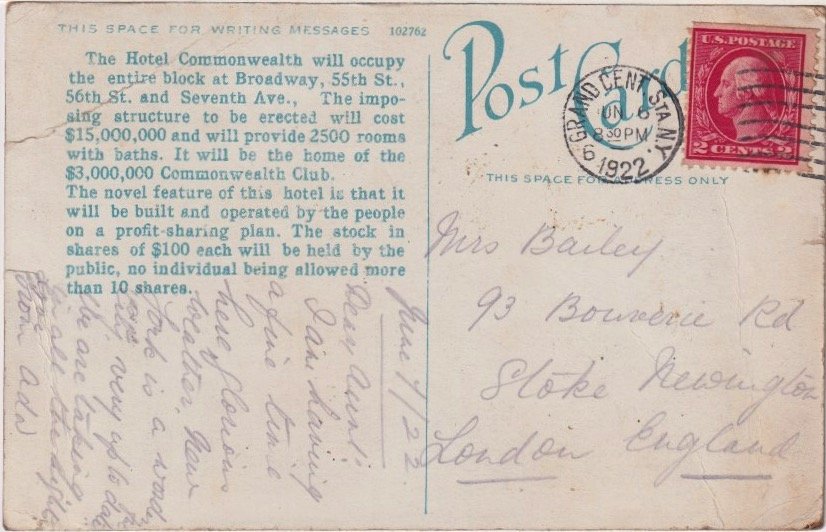
-

Halifax, Canada, April 1 1906
In this fascinating card, a woman called Bertha has sent a card to Ethel’s mother from Halifax, Nova Scotia, the arrival point for many UK emigrants to Canada. The postcode is Halifax but the card is of New York - did it call there on the journey? Maria obviously has a maternal attitude to Bertha as Bertha has been instructed to let her know the minute she arrives. The card reads simply “Dear Mrs Bailey, Have just [with this word added in for emphasis] arrived quite safely at Halifax, will write you more fully later. Bertha”
-

-
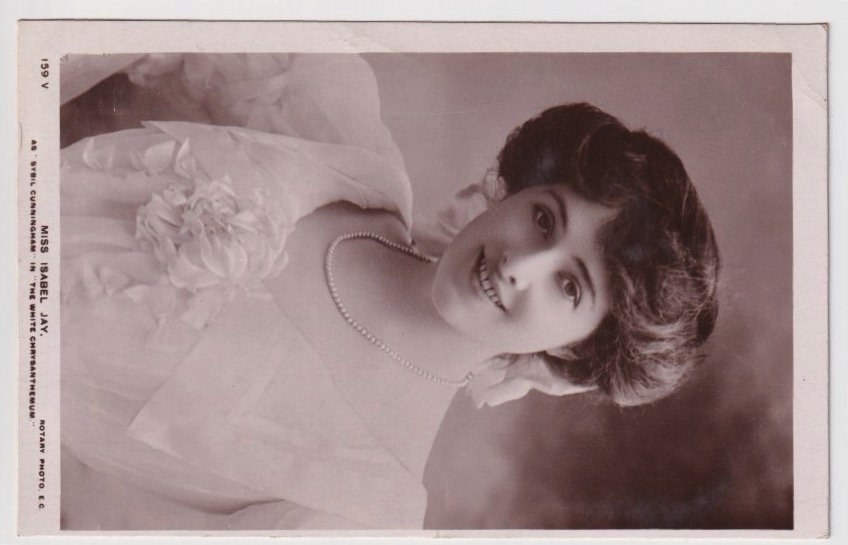
London, March 21 1906
Ada sends a postcard of opera singer Isabel Jay to Emily that deals initially with trivia: “Would you please order one of those Knitting Books when you are going that way. Yours affectionately, Ada” Then, above the message she adds: “The Pretoria has arrived at Halifax.” Is she letting her aunt know that Bertha’s boat has arrived or is this connected to yet another departure in the family?
-

-

Niagara Falls, 11 August 1906
Four months later, Bertha is on a trip to Niagara Falls in Ontario. She writes “To Miss Emily Bailey: With Bags of Love & Best Wishes from your Old Pal Bertha”.
-

-

Banff, Alberta, Nov 12 1906
Bertha is now 3,000 miles west of Halifax. This card was sent to Miss Bailey: “Bags of love to you all. Arthur sends a lump Gratis. Your Old Pal Bertha.”
-

-
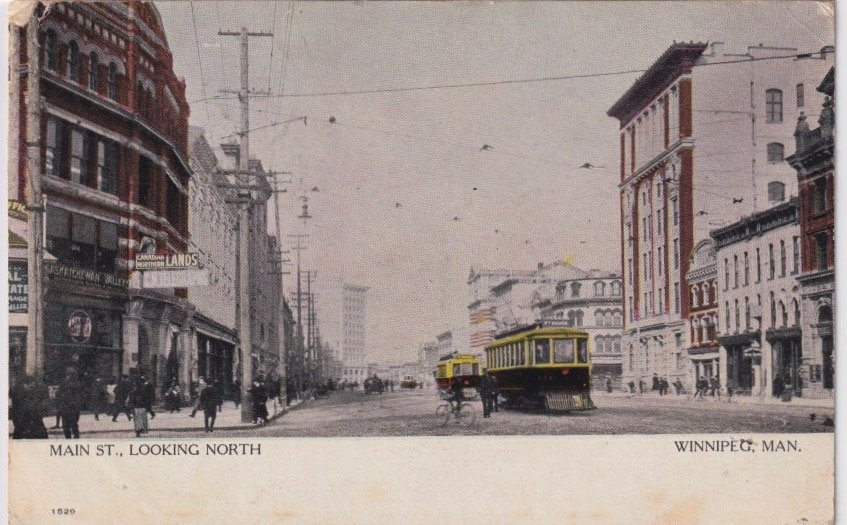
Winnipeg, March 25 1907
Is Winnepeg where Bertha made her home? This postcard is the final one from her. Sent to Emily it simply says, as usual: “Bags of love from your old pal Bertha”.
-

Alf’s Paris trip, 1907
-

Boulogne-sur-Mer. Les Quais
The last one. We leave Folkestone @ 2.0pm Sat. No message, just the address.
-
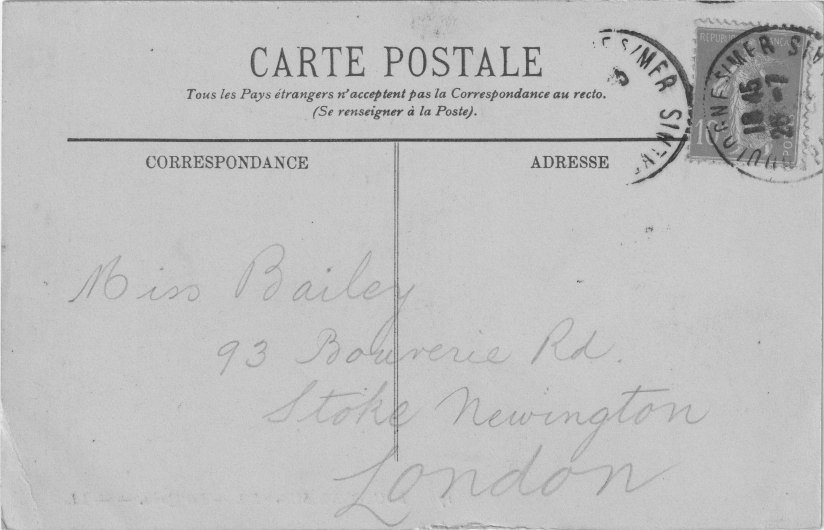
New List Item
Flipside of Boulogne - all but one of the Paris postcards are written in pencil.
-

Paris - panorama de l'Avenue des Champs-Elysées
“Fearfully hot here. Went to Versailles today where the Palais of Louis XIV, but now a museum. Alf” No message, just the address.
-

Paris. Le Théatre du Gymnase et le Boulevard Bonne-Nouvelle.
No message. The postmark gives the date 24-7-07 and it has been sent from ‘Dunkerque’.
-
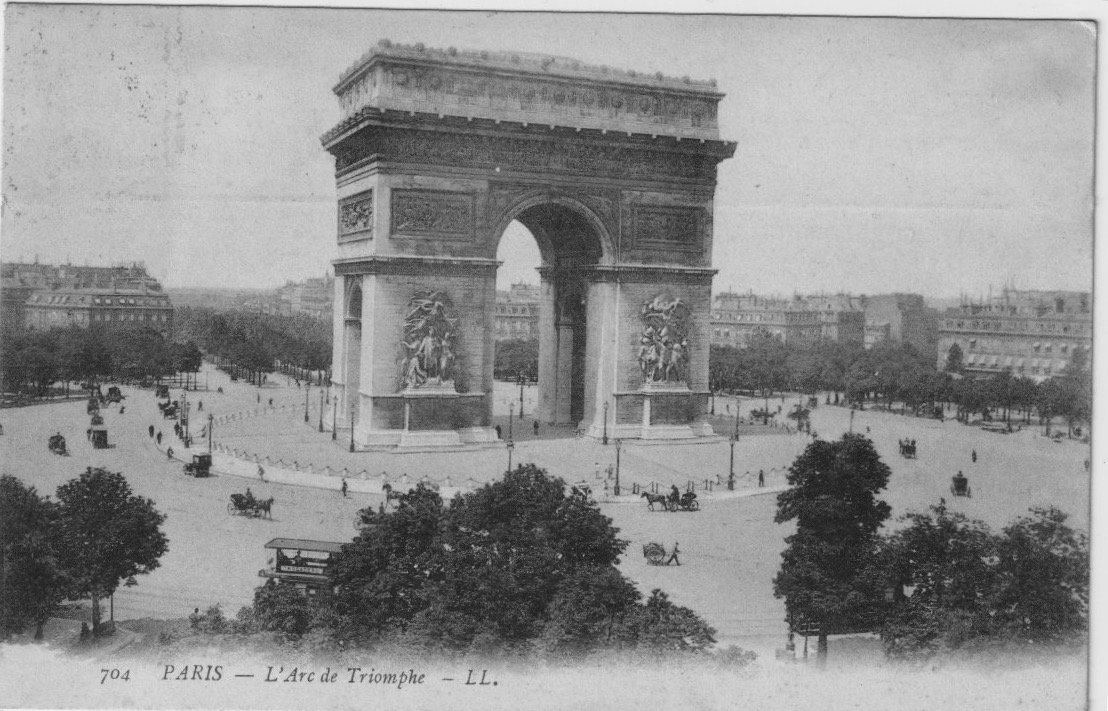
Paris. Arc de Triomphe
18.30. 30-07-07. No message.
-
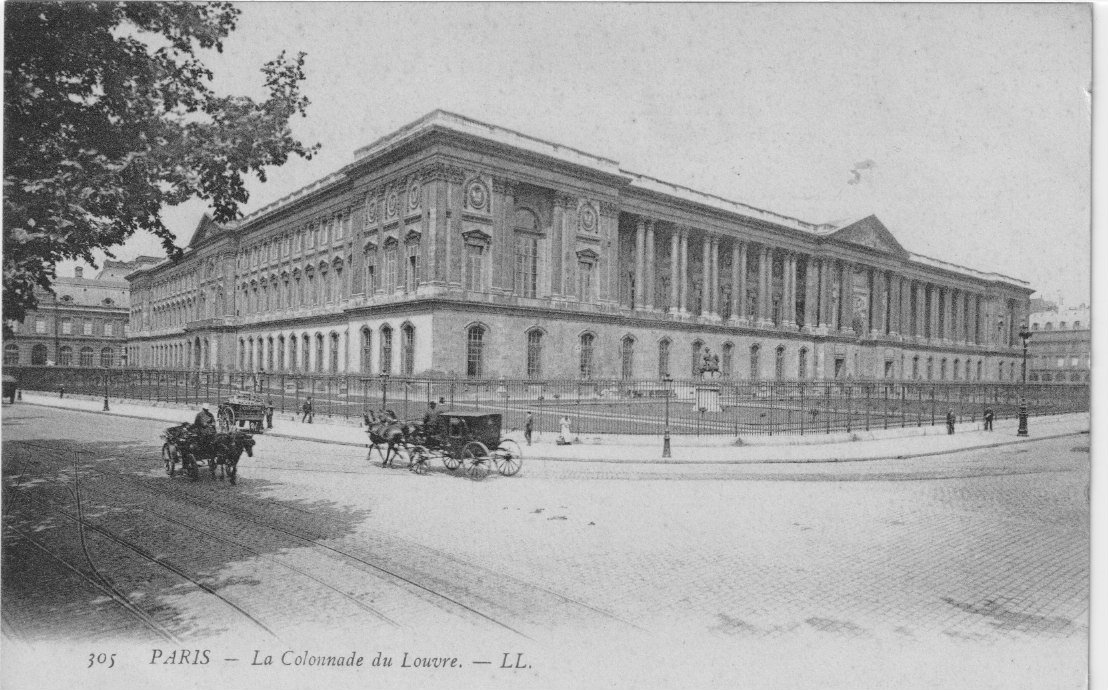
Paris. Le Colonnade du Louvre
Postmarked 27-7-07. No message.
-

L'Eglise de la Madeleine
Unsent. Given when he got home?
A pair of jokers
-

August 9 1907
Sent from her holiday to Ethel in Great Yeldham: “Dear Ethel, Glad you are enjoying yourself, keep on doing so. Miss xxxxx thank for card, don’t you wish you were in Brighton so you could be clasped in the arms of a xxxx fisherman. Love Ria
-

New List Item
Description goes here -

Home, September 10 1909
Ted is writing to his sister “Em” who is on holiday in Great Yarmouth, Norfolk.`His first thought is to say. “Bloaters arrived tonight all right - thanks.” Then he gives her a list of train times from South Town, Great Yarmouth to Liverpool Street, London and it seems he is arranging to meet her at the station to escort her home.
-

New List Item
Description goes here -

Great Yarmouthxxx 9 date unclear
“Yarmouth Sunday. Shall be home Wednesday night some time. Ted.
-
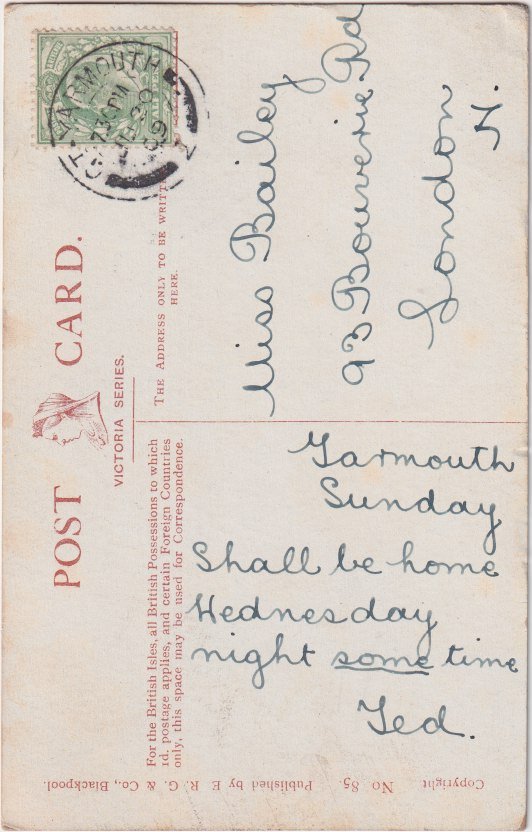
New List Item
Description goes here
Jim sails the world
-
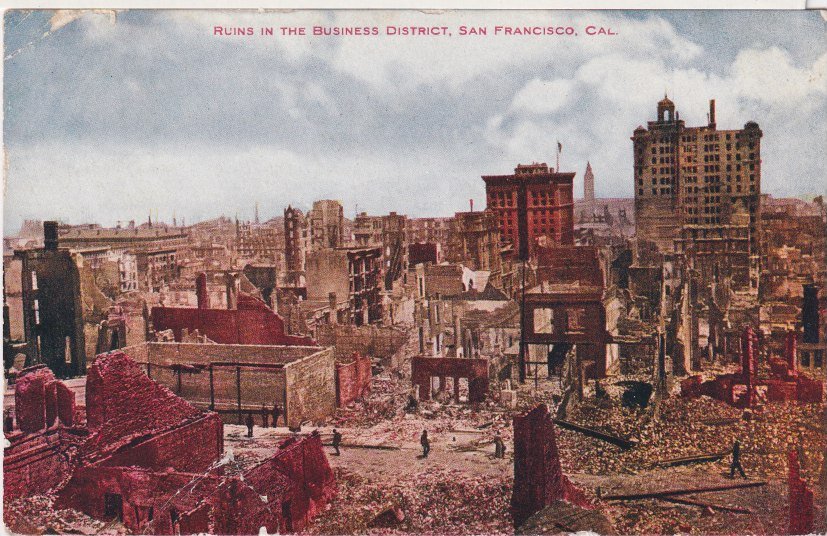
Ruins in the Business District, San Francisco, August 26 1910
Aug 26 1910. “Went and saw a mutual friend of ours last night Mr Max Linden. Jim.
-

-

Shasta Springs, California, 1911
To Mrs Bailey. Date indecipherable. “On my way here the train stopped at t his place for the passengers to take the waters. Jim.”
-

New List Item
Description goes here -

Indian Native Son of California, January 14 1911
To Mrs Bailey. Jan 4 1911. “Have just read about the great battle of London. Must be rotten to have to live in such an uncivilised part of the world. If you have not yet sent the pies put a nice bag [of] scotch shortbread in with them. Jim”
-

New List Item
Description goes here -
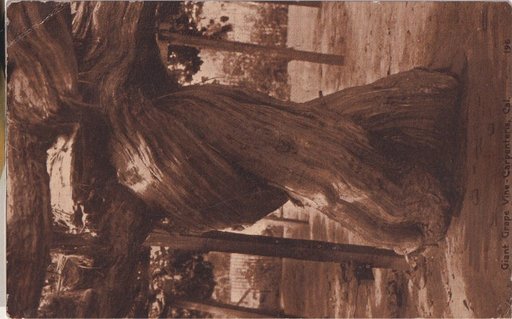
Giant grave vine, California, January 10 1911
To Mrs Bailey: “Should be pleased if you would send out “Lloyds” every week as the fellow that used to get it has left us. I think the boat leaves Liverpool on Wednesdays so that if you post it Monday night or Tuesday morning it will catch the boat. If the paper with the particulars of the great battle of London is still around please send that as well. Jim”
-
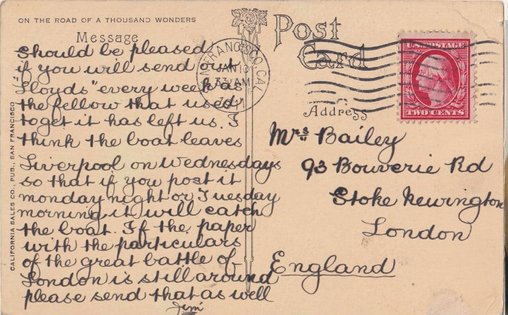
New List Item
Description goes here -
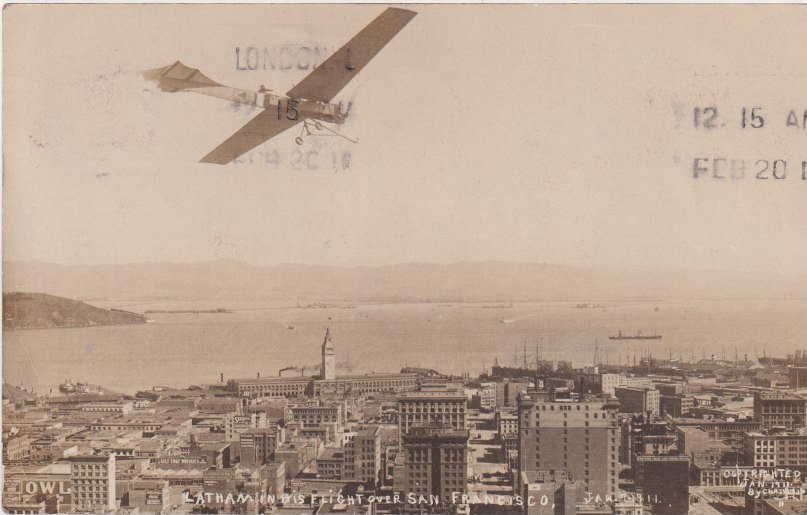
Latham flies over San Francisco, February 20 1911
Jim writes to his mother, dated Feb 4 1911. Have just eaten some of the mince pies. swell
Jim
-

-

Glacier Point, Yosemite
To Mrs Bailey: “ have just received the links They would have cost a dollar out here. Another fellow out here has taken a fancy to them so I offered to have a pair sent out. No hurry, any time will do. Couldn’t you put a little cotton wool round the studs then paper and put them in an envelope. I think they would reach me right. Jim
-

New List Item
Description goes here -
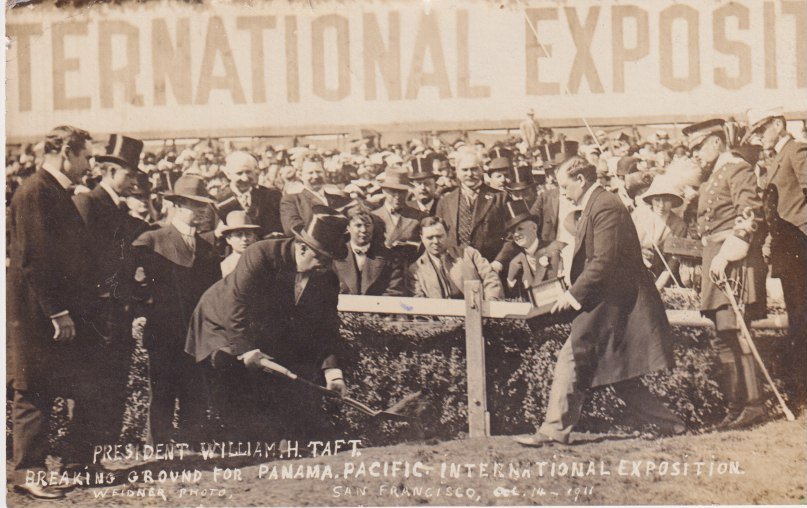
International Exposition, San Francisco, December 29 1911
To his mother: “It is rumoured but not yet confirmed that I sail for China next Wednesday. More anon. Jim”
-

-

Farmwork, Japan, March 15 1913
To Mrs Bailey: “The road-the-world steamship Cleveland passed us coming out of Nagasaki harbour and the German band played that soul stirring tune The Star Spangled Banner. Jim”
-

-

On the way home, Nov 17 1913
Jim writes to his mother: “Have received all the letters you addressed to the old address including the initials. We are now 300 miles from home and expect to arrive at 10am tomorrow morning. Jim”. The underlining of the word home says it all!
-

New List Item
Description goes here
“Another one for your collection”
-

Dream it.
James, the missing sibling in the 1910 census, sends postcards from around the world, signed simply ‘Jim’. Ethel spoke of a nephew in the merchant navy so perhaps this was James son and they shared the same career. Some cards contain jokes, others requests for favourite foods to be sent out to him, some have no message and presumably can be interpreted as ‘Doing ok, thought this would interest you’.
-

Build it.
The first postcards to be divided in two on the flip side, one half for the message and the other for the address, were introduced in 1902. From that year to the outbreak of the First World War, postcards were a huge craze. That ended with the war - many cards were made in Germay and never achieved that popularity again. People sent them just to add to someone’s collection as well as to pass on nws.
